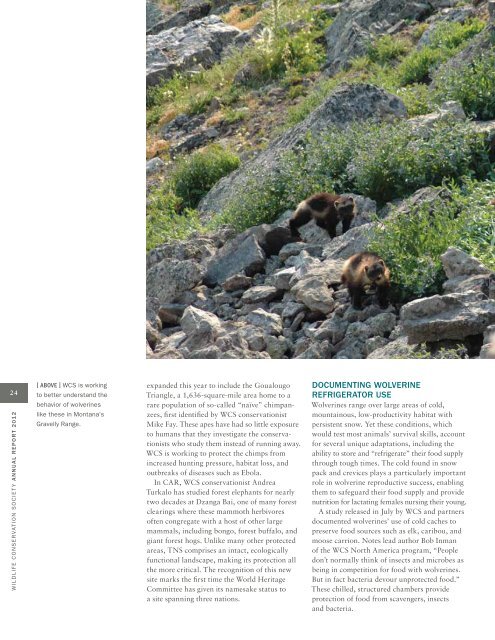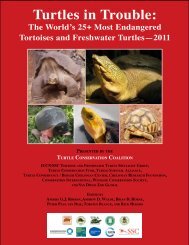WCS Annual Report 2012 - Wildlife Conservation Society
WCS Annual Report 2012 - Wildlife Conservation Society
WCS Annual Report 2012 - Wildlife Conservation Society
You also want an ePaper? Increase the reach of your titles
YUMPU automatically turns print PDFs into web optimized ePapers that Google loves.
24<br />
wildlife conservation society <strong>Annual</strong> <strong>Report</strong> <strong>2012</strong><br />
[ above ] <strong>WCS</strong> is working<br />
to better understand the<br />
behavior of wolverines<br />
like these in Montana’s<br />
Gravelly Range.<br />
expanded this year to include the Goualougo<br />
Triangle, a 1,636-square-mile area home to a<br />
rare population of so-called “naïve” chimpanzees,<br />
first identified by <strong>WCS</strong> conservationist<br />
Mike Fay. These apes have had so little exposure<br />
to humans that they investigate the conservationists<br />
who study them instead of running away.<br />
<strong>WCS</strong> is working to protect the chimps from<br />
increased hunting pressure, habitat loss, and<br />
outbreaks of diseases such as Ebola.<br />
In CAR, <strong>WCS</strong> conservationist Andrea<br />
Turkalo has studied forest elephants for nearly<br />
two decades at Dzanga Bai, one of many forest<br />
clearings where these mammoth herbivores<br />
often congregate with a host of other large<br />
mammals, including bongo, forest buffalo, and<br />
giant forest hogs. Unlike many other protected<br />
areas, TNS comprises an intact, ecologically<br />
functional landscape, making its protection all<br />
the more critical. The recognition of this new<br />
site marks the first time the World Heritage<br />
Committee has given its namesake status to<br />
a site spanning three nations.<br />
Documenting Wolverine<br />
Refrigerator Use<br />
Wolverines range over large areas of cold,<br />
mountainous, low-productivity habitat with<br />
persistent snow. Yet these conditions, which<br />
would test most animals’ survival skills, account<br />
for several unique adaptations, including the<br />
ability to store and “refrigerate” their food supply<br />
through tough times. The cold found in snow<br />
pack and crevices plays a particularly important<br />
role in wolverine reproductive success, enabling<br />
them to safeguard their food supply and provide<br />
nutrition for lactating females nursing their young.<br />
A study released in July by <strong>WCS</strong> and partners<br />
documented wolverines’ use of cold caches to<br />
preserve food sources such as elk, caribou, and<br />
moose carrion. Notes lead author Bob Inman<br />
of the <strong>WCS</strong> North America program, “People<br />
don’t normally think of insects and microbes as<br />
being in competition for food with wolverines.<br />
But in fact bacteria devour unprotected food.”<br />
These chilled, structured chambers provide<br />
protection of food from scavengers, insects<br />
and bacteria.







![RaLand / SeaScape [PDF] - Wildlife Conservation Society](https://img.yumpu.com/49974326/1/190x245/raland-seascape-pdf-wildlife-conservation-society.jpg?quality=85)









